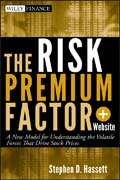
The risk premium factor: a new model for understanding the volatile forces that drive stock prices
Hassett, Stephen D.
A radical, definitive explanation of the link between loss aversion theory, the equity risk premium and stock price, and how to profit from it The Risk Premium Factor presents and proves a radical new theory that explains the stock market, offering a quantitative explanation for all the booms, busts, bubbles, and multiple expansions and contractions of the market we have experienced over the past half-century.Written by Stephen D. Hassett, President of Hassett Advisors, a specialist in value management, new venture strategy, development, and execution for high technology, web, and mobile businesses, the book convincingly demonstrates that the equity risk premium is proportional to long-term Treasury yields, establishing a connection to loss aversion theory. Explains stock prices from 1960 through the present including the 2008/09 'market meltdown' Shows how the S&P 500 has consistently reverted to values predicted by the model Solves the equity premium puzzle by showing that it is consistent with findings on loss aversion Demonstrates that three factors drive valuation and stock price: earnings, long term growth, and interest rates Understanding the stock market is simple. By grasping the simplicity, business leaders, corporatedecision makers, private equity, venture capital, professional, and individual investors will fully understand the system under which they operate, and find themselves empowered to make better decisions managing their businesses and investment portfolios. ÍNDICE: List of Figures. List of Tables. Preface. Evolution of a Theory. Overview. How This Book Is Structured. As You Begin. Acknowledgments. About theAuthor. Chapter 1: Understanding the Simplicity of Valuation. Rates, Compounding and Time Value. Why Time Value Matters for the Stock Market. Valuing a Perpetuity. Constant Growth Equation: The Key to Understanding the Stock Market. Not the First to Try This. Why Growth Rate and Cost of Capital Matter. P/E Ratio Expansion and Contraction. CAPM, Risk Premium and Valuation. Equity Risk Premium. Impact of Risk Premium on Valuation. Chapter Recap. Part I: Exploring the Risk Premium Factor Valuation Model. Chapter 2: The Risk Premium Factor Valuation Model. The RPF Model is Simple, but Does it Work? Estimating the Risk Premium Factor (RPF). Potential Causes for Shifts in the Risk Premium Factor. Potential Weaknesses in RPF Theory and Methodology. Adjusted Risk Free Rate. Comparison to the Fed Model. Chapter Recap. Chapter 3: Solving the Equity Premium Puzzle. The Link to Loss Aversion. Loss Aversion. Loss Aversion and Corporate Decision Making. Attempts to Solve the Equity Premium Puzzle. Impact of Inflation on Value. Back to Loss Aversion. Our Reptilian Brain. Chapter Recap. Chapter 4: The RPF Model and Major Market Events from 1981-2009. Efficient MarketHypothesis. How the RPF Valuation Model Explains Black Monday. 2000 Dot Com Bubble: RPF Model Suggests Significant Bubble for the S&P 500. How the RPF Valuation Model Explains 2008-2009 Meltdown and Recovery. Markets Mostly Efficientand Rational, But Prone to Mistakes. Chapter Recap. Part II: Applying the Risk Premium Factor Valuation Model. Chapter 5: Application to Market Valuation. Beware of Interest Rates. Example: Application to the Market in Late September2009. Why the Source of Growth Matters. Chapter Recap. Chapter 6: Risk Adjusted Real Implied Growth Rate (RIGR). Analyzing Individual Companies with RIGR. RIGR Analysis of Apple and Google Pre-Earnings Announcement. Chapter Recap. Chapter 7: Valuing an Acquisition or Project. Brief Introduction to Valuing an Acquisition or Project. Translating Your World View into Numbers. Setting the Cost of Capital. Example: Utility Acquiring a Risky Asset. Selecting the Investment Forecast Time Horizon. The All Important Terminal Value. Chapter Recap. Chapter 8: Case Study #1 - Valuation of a High Growth Business. Calculating Enterprise Value and Stock Price. Scenario Analysis. Chapter Recap. Chapter 9: Case Study #2 - Valuation of a Cyclical Business. Chapter Recap. Chapter 10: Using the RPF Model to Translate Punditry. The varied voices of columnists, writers and sources in financial media are often confusing. This chapter summarizesa selection of recent articles from the financial press and analyzes them through the lens of the RPF Model. Read Carefully Then Analyze. What Have I Got to Lose? Beware of Oversimplification. Confusing Headlines and Misguided Blame.Almost Nailed It. Graham and Dodd. The Wrong
- ISBN: 978-1-1180-9905-6
- Editorial: John Wiley & Sons
- Encuadernacion: Cartoné
- Páginas: 208
- Fecha Publicación: 14/09/2011
- Nº Volúmenes: 1
- Idioma: Inglés
